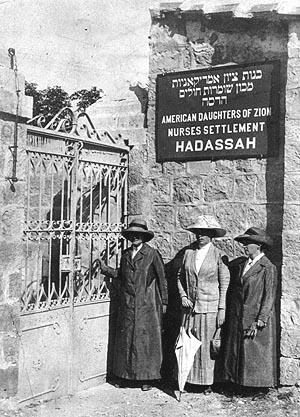Rose Kaplan
Rose Kaplan studied at the Mount Sinai Hospital Training School for Nurses before serving as a nurse in the Spanish-American War. In 1913 she was hired by Hadassah to help establish their district visiting nursing program in Palestine. As conditions worsened during World War I, Kaplan returned to America in 1915, where she learned that she had cancer. Despite the diagnosis, she insisted that Hadassah send her to work in a refugee camp set up by the British in Alexandria, Egypt, for Jews expelled from Palestine. Once there, she worked primarily with children, teaching hygiene and treating skin diseases and trachoma, an eye infection that causes blindness when left untreated. While working in Palestine and Egypt, Kaplan regularly sent back optimistic reports of her work, which were published in Hadassah’s newsletters to show members how the organization’s work was paying off in direct service to settlers and refugees.
Rose Kaplan was a pioneer in health care in Palestine and helped to initiate the medical work funded by Hadassah, the Women’s Zionist Organization of America, in the years after its founding in 1912.
Early Life and Hadassah Nursing Career
Born on September 4, 1867, in Petrograd (St. Petersburg), Russia, Kaplan immigrated to the United States in 1892. After graduating from Mount Sinai Hospital Training School for Nurses, she served as a nurse in the Spanish-American War. Although not a Zionist, she was hired by Hadassah in 1913 to travel to Palestine and set up its district visiting nursing program, along with Rae Landy. Together, with financial assistance from Nathan and Ida Straus, Kaplan and Landy set up the Hadassah Nurses Settlement in the Mea Shearim section of Jerusalem. While the aim of the nurses was to provide health care to patients in Jerusalem and other settlements, they received almost no cooperation from local doctors, who were unaccustomed to visiting nurses and viewed them as little more than assistants. Eventually, Kaplan and Landy established working relationships with a few doctors, doing maternity work and trachoma prevention in Jewish schools.
With the outbreak of World War I, when shipments of supplies and communication with the West became difficult, Hadassah offered to release the two nurses from their contracts, although they decided to continue their work in Jerusalem. As conditions deteriorated, however, both Kaplan and Landy returned to the United States, leaving the settlement in the hands of Dr. Helena Kagan, who had established a medical practice there.
Hadassah Work in Egypt
Arriving back in New York in January 1915, Kaplan expressed to Hadassah officials her desire to be sent to work as a nurse in the refugee camp set up by the British in Alexandria, Egypt, for Jews expelled from Palestine. While in the United States, she underwent surgery for cancer, but chose to return to work despite a poor prognosis. In November, she sailed for the Middle East, but her ship, the SS Athenai, caught on fire after two days at sea. The passengers were rescued, and Kaplan was returned to New York, where she resolutely demanded to be sent again to Alexandria.
In Alexandria, she carried on trachoma work, treated children with skin diseases, fought malnutrition, and taught hygiene to children. She distributed clothing and linens sewn by Hadassah women and sent cheerful descriptions of her activities back to the American organization. From both Jerusalem and Alexandria, her detailed and optimistic reports to Hadassah, many of which were published in the Hadassah Newsletter, promoted the Zionist cause among American Jewish women, allowing them to see the tangible results of their organizational efforts.
Death and Legacy
Although failing in health and constantly losing weight, Kaplan determined to continue her work and never revealed her condition to her American sponsors. She died in Alexandria on August 3, 1917, and was buried there among the Jewish soldiers of the Zion Mule Corps. Several years later, her remains were moved to Jerusalem under Hadassah auspices and reburied on the Mount of Olives. In the months after Kaplan’s death, Henrietta Szold, the founder of Hadassah, wrote that if the organization’s medical work was to resume in Palestine after the war, it could do so only by emulating the selflessness and dedication to public service that Kaplan had exemplified.
AJYB 20 (1918–1919): 229.
Brownstone, Mina. “Rose S. Kaplan, 1867–1917.” Typescript, Hadassah Archives, NYC.
Dash, Joan. Summoned to Jerusalem: The Life of Henrietta Szold (1979).
Obituary. NYTimes, August 8, 1917, 7:4.
Szold, Henrietta. “Rose Kaplan.” Maccabaean 31 (1918): 37–39.





